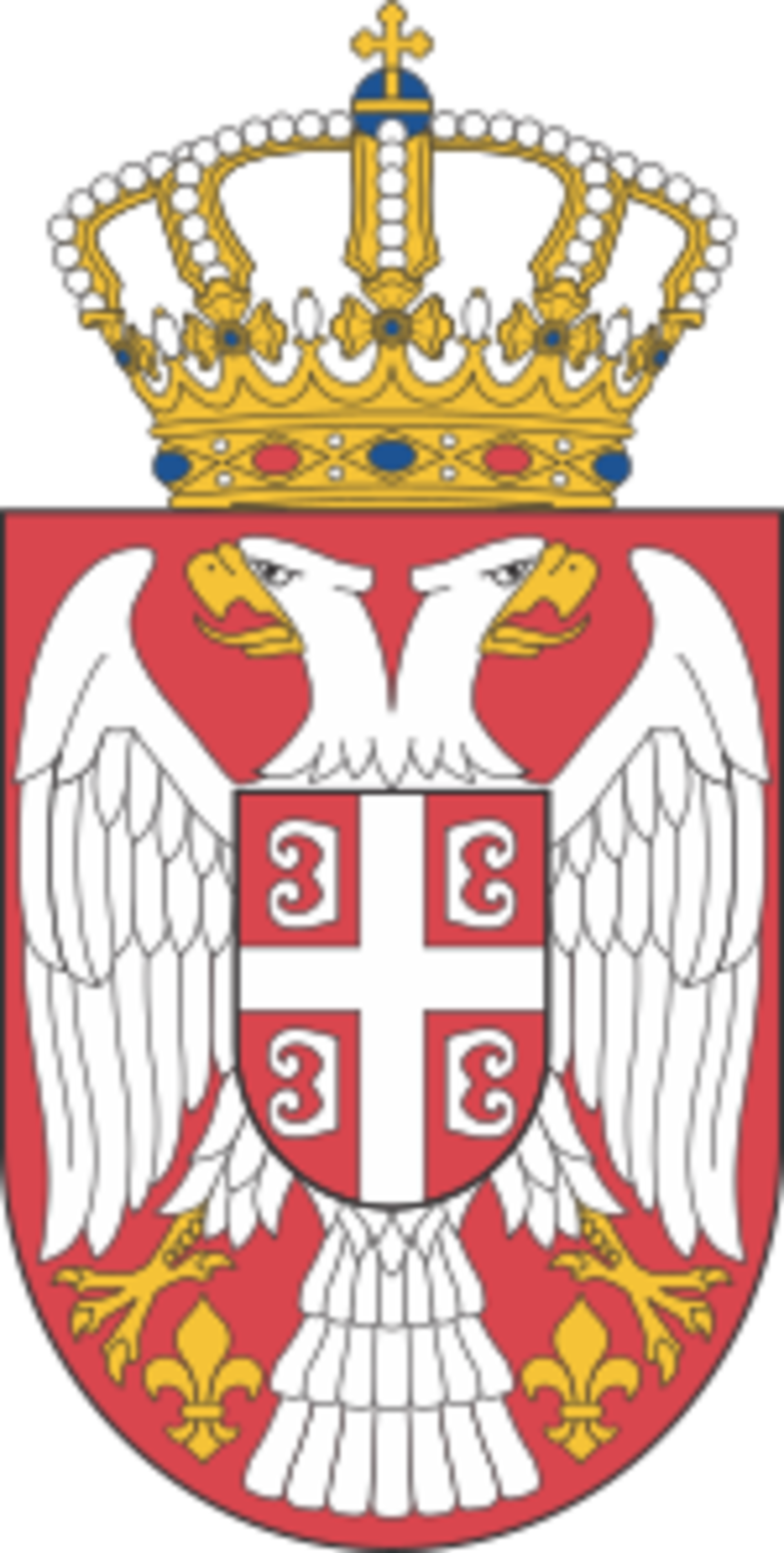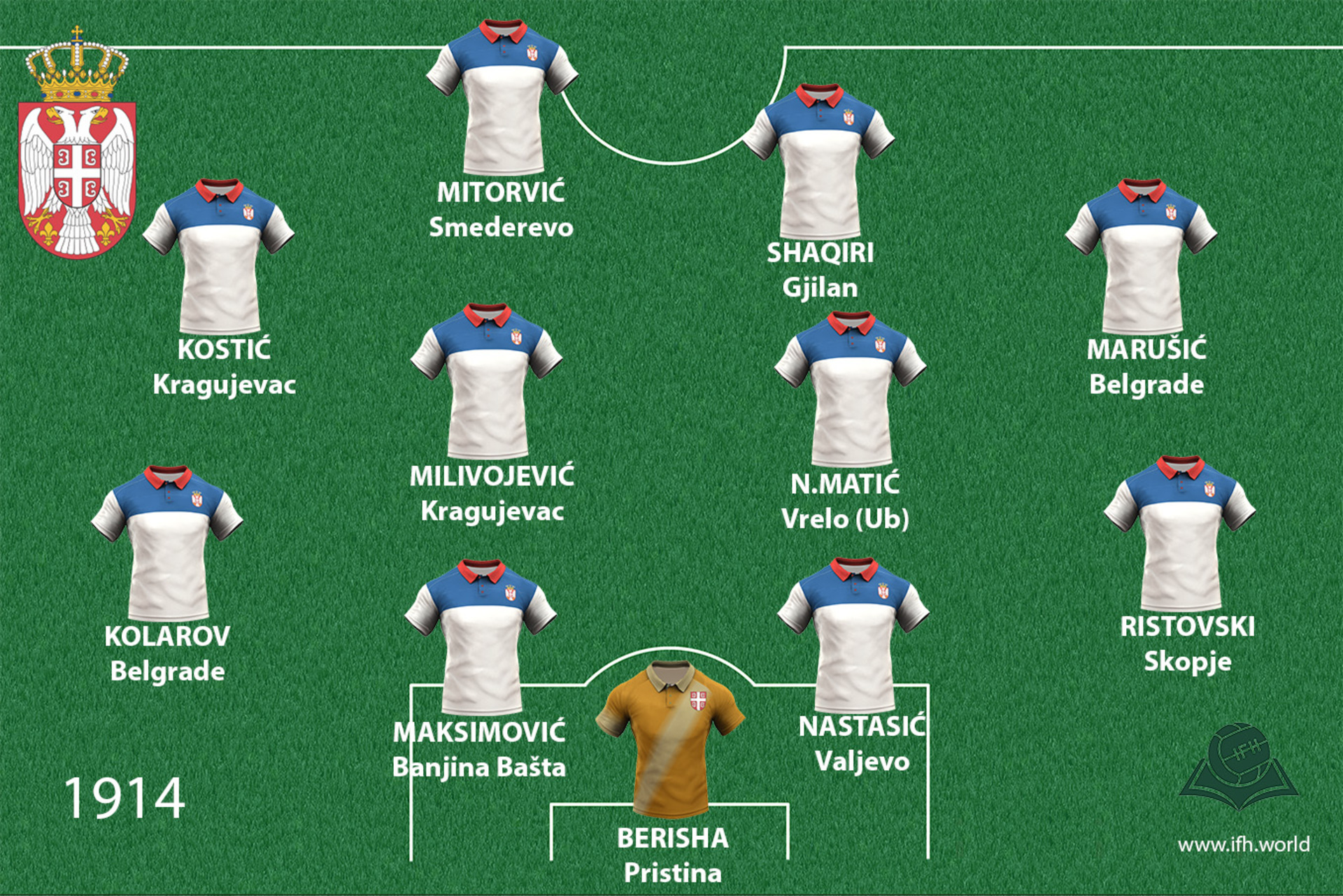Kingdom of Serbia
After succeeding in gaining complete independence from the Ottomans at the Berlin Congress (1878), Serbia soon became the kingdom on whose throne the Obrenovic family would be found, and then after the bloody conspiracy of 1903, the anti-Austrian Karađorđevićs.

Coat of arms
Shirt
| Position | First name | Last name | Mjesto rođenja | Like | Dislike | |
|---|---|---|---|---|---|---|
| GK | Etrit | BERISHA | Pristina |
17 |
26 |
|
| GK | Predrag | RAJKOVIĆ | Negotin |
27 |
4 |
|
| GK | Vladimir | STOJKOVIĆ | Ložnica |
21 |
2 |
|
| DC | Matija | NASTASIĆ | Valjevo |
63 |
6 |
|
| DC | Milan | BIŠEVAC | Kosovska Mitorvica |
3 |
1 |
|
| DC | Nikola | MILENKOVIĆ | Belgrade |
18 |
7 |
|
| DC | Uroš | SPAJIĆ | Belgrade |
4 |
1 |
|
| DRLC | Nenad | TOMOVIĆ | Kragujevac |
22 |
6 |
|
| DRL/MR | Adam | MARUŠIĆ | Belgrade |
6 |
1 |
|
| DRL/MR | Stefan | RISTOVSKI | Skopje |
28 |
10 |
|
| DR/MR | Dušan | BASTA | Belgrade |
4 |
1 |
|
| DL/ML | Aleksandar | KOLAROV | Belgrade |
45 |
13 |
|
| DL/ML | Ivan | OBRADOVIĆ | Obrenovac |
15 |
4 |
|
| DMC | Luka | MILIVOJEVIĆ | Kragujevac |
30 |
9 |
|
| DMC | Nemanja | MATIĆ | Vrelo |
60 |
10 |
|
| DMC | Valon | BEHRAMI | Kosovska Mitrovica |
1 |
2 |
|
| MC | Marko | GRUJIĆ | Belgrade |
13 |
3 |
|
| MC | Nemanja | GUDELJ | Belgrade |
2 |
0 |
|
| MC | Nikola | MAKSIMOVIĆ | Belgrade |
27 |
14 |
|
| MC | Zlatko | JUNUZOVIĆ | Loznica |
11 |
9 |
|
| AMRLC | Filip | ĐURIČIĆ | Obrenovac |
9 |
1 |
|
| AMRLC | Milot | RASHICA | Vushtrri |
4 |
11 |
|
| AMRL | Andrija | ŽIVKOVIĆ | Niš |
18 |
3 |
|
| AMRL | Filip | KOSTIĆ | Kragujevac |
29 |
9 |
|
| AMRL | Lazar | MARKOVIĆ | Čačak |
18 |
7 |
|
| AMRL | Xerdan | SHAQIRI | Gjilan |
44 |
26 |
|
| FRLC | Admir | MEHMEDI | Gostivar |
5 |
15 |
|
| FRLC | Uroš | ĐURĐEVIĆ | Belgrade |
8 |
8 |
|
| FC | Aleksandar | MITROVIĆ | Smederevo |
31 |
10 |
|
| FC | Ilija | NESTOROVSKI | Prilep |
24 |
5 |
(Today: Central and Southern Serbia, Macedonia, Kosovo)
As the plan for realizing Dusan Serbia, on whose territory Serbian ideologists claimed historical rights, failed due to the emergence of independent Greece (1829) and then Bulgaria (1878), aspirations for territorial expansion to the South Slavic parts of Austria-Hungary have emerged. In doing so, they invoked the natural or ethnic right to live of a nation in the same state. Specifically, the religious theory of identifying Serbianness with Orthodoxy was complemented by a linguistic theory of equating Serbianness with the Stokavian language. Consequently, such a vision of belonging to the Serbian nation also automatically meant the denial of other national identities, which were simultaneously constructed in these areas, primarily Croatian in Slavonia, Dalmatia and Bosnia and Herzegovina.
The Orthodox Church, as the only surviving institution from medieval Serbia, played the most important role in constructing a Serbian national identity. At its core, however, is the myth of the Battle of Kosovo, which contains all the elements necessary for its construction and maintenance: heroism, the golden age, the culprits and causes of its disappearance, etc. At the same time, it promotes "Serb vulnerability" and an almost paranoid way of looking of the world as a “conspiracy against Serbia that resists everything”. In these circumstances, the Serbian summit will encourage and support anti-Habsburg elements in Austria-Hungary (especially in BiH), which will ultimately lead to the outbreak of World War I.
Sources
- Srećko Matko DŽAJA, Politička realnost jugoslavenstva : (1918. - 1991.) , Sarajevo, 2004.
- Ivan PEDERIN, Dalmacija i Hrvati u vanjskoj politici bečkoga dvora, Zadar, 2005.
- Sabrina Petra RAMET, Tri Jugoslavije : izgradnja države i izazov legitimacije : 1918.- 2005., Zagreb, 2009.
- Srđan ŠLJUKIĆ, '' Kulturni resursi i sukob: Kosovo između istorije i morala'', Mitovi nacionalizma i demokratija'' (ur. Ljubiša Despotović, Darko Gavrilović, Vjekoslav Perica, Srđan Šljukić), Novi Sad, 2009.
- Coat of arms: https://en.wikipedia.org/wiki/Coat_of_arms_of_Serbia
